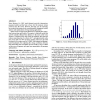84 search results - page 13 / 17 » A Line Drawings Degradation Model for Performance Characteri... |
ISMB
2000
13 years 9 months ago
2000
Knowing the number of residue contacts in a protein is crucial for deriving constraints useful in modeling protein folding, protein structure, and/or scoring remote homology searc...
INFOCOM
2006
IEEE
14 years 1 months ago
2006
IEEE
— As the commercial success of the IEEE 802.11 protocol has made wireless infrastructure widely deployed, user organizations are increasingly concerned about the new vulnerabilit...
WINET
2010
13 years 6 months ago
2010
Object tracking in wireless sensor networks is to track mobile objects by scattered sensors. These sensors are typically organized into a tree to deliver report messages upon dete...
ICIP
2009
IEEE
14 years 8 months ago
2009
IEEE
Fluorescent protein microscopy imaging is nowadays one of the most important tools in biomedical research. However, the resulting images present a low signal to noise ratio and a ...
POPL
2007
ACM
14 years 8 months ago
2007
ACM
Reuse distance (i.e. LRU stack distance) precisely characterizes program locality and has been a basic tool for memory system research since the 1970s. However, the high cost of m...

